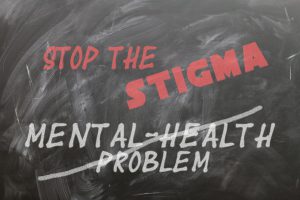October 10th is World Mental Health Day, a time, according to the World Health Organization, “to raise awareness of mental health issues around the world and to mobilize efforts in support of mental health.” And if it seems to you like we’ve all been thinking and talking nonstop about mental health since the start of the pandemic shifted all of our paradigms, you’re right – in a way. 2020 brought mental health issues into sharp relief as many of us struggled with loneliness, anxiety, and even depression, but we still aren’t really where we should be when it comes to supporting people in their struggles. To be honest, while things have gotten a whole lot better in the field of mental health over the past decade or so, we still have a long way to go when it comes to truly making our mental health as much a priority (and as little a taboo) as our physical health.
The Grim Statistics
When it comes to the state of mental health, and mental health care, in the United States, there’s good news and bad news, and we’re going to hit you with the bad news first. The state of mental health in America in 2021 is, well, not great: because some of the data we have for this year relies on what happened last year (the notorious 2020), we’re looking at a pretty grim picture, although mental health in the U.S. seems to have been deteriorating well before the pandemic hit.
For example, just take a look at these stats:

- In 2017-2018, 19% of adults experienced a mental illness, an increase of 1.5 million people from the year before.
- The percentage of adults in the U.S. who are experiencing serious thoughts of suicide increased 0.15% from 2016-2017 to 2017-2018 – an additional 460,000 people from the year before.
- There is still an unmet need for mental health treatment among youth and adults: 60% of youth with major depression did not receive any mental health treatment in 2017-2018, and 23.6% of adults with a mental illness reported an unmet need for treatment in 2017-2018.
But, of course, the pandemic has made things even rougher:
- 9.7% of youth in the U.S. have severe major depression, compared to 9.2% last year.
- The number of people looking for help with anxiety and depression skyrocketed in 2020: 315,220 people took a screening for anxiety, a 93% increase over the 2019 total number of anxiety screens. 534,784 people took the depression screen, a 62% increase over the 2019 total number of depression screens.
- From April to September 2020, among people who screened with moderate to severe symptoms of anxiety or depression, 70% reported that one of the top three things contributing to their mental health concerns was loneliness or isolation.

- African American screeners have had the highest average percent change over time for anxiety and depression, while Native American screeners have had the highest average percent change over time for suicidal thoughts.
- In September 2020, over half of 11-17-year-olds reported having thoughts of suicide or self-harm more than half or nearly every day of the previous two weeks. From January to September 2020, 77,470 youth reported experiencing frequent suicidal ideation, including 27,980 LGBTQ+ youth.
- Over 8 in 10 people who took an anxiety screening scored with moderate to severe symptoms in September 2020. Over 8 in 10 people who took a depression screen have scored with symptoms of moderate to severe depression consistently since the beginning of the pandemic in March 2020.
- 37% of people reported having thoughts of suicide more than half or nearly every day in September 2020.
All of this can seem overwhelming to think about, but the positive thing is that we are thinking about it, and there are things that are improving when it comes to mental health in the U.S.
How We’re Improving
Now, it’s time to look at the better news – and one of the biggest pieces of good news is that this data is so readily available, and that it’s being studied, discussed, and worried about. And that brings us to our first improvement:
The term “mental health” is not so stigmatized anymore

For centuries, “mental health,” or any terms related to psychological health as opposed to physical health, have only been used to talk only about severe forms of illness, or have been highly charged and stigmatized. But these days, we can talk about “mental health” as one part of our overall health, and the term is more inclusive, including anything from as simple as taking care of yourself holistically to getting treatment for anxiety or depression.
Experts agree that bringing mental health out in the open has had a positive effect: according to Dr. Mark van Ommeren, a mental health expert who works with the World Health Organization, “Years of study after study showing that [mental health] conditions are common have created a snowball effect. Media has played a positive role here, as have influential people who are starting to speak more about their mental health, which helps to reduce the stigma.”
One way we still need to improve in this regard? According to Kryss Shane, a social worker and educator, “We continue to see mental healthcare as a response to problems, rather than something recommended for everyone as a way to improve life in general. If we are able to alter this understanding, it will not only further remove stigma, it will encourage people to seek out help before they are in crisis.”
The law has made mental health equal to physical health
The first decade of the twentieth century saw some extremely important changes to the way we treat mental health on a governmental level, which has greatly improved access for a lot of people. The Mental Health Parity and Addiction Equity Act of 2008 and the Affordable Care Act (ACA) of 2010 both put mental health on par with physical health when it comes to what’s covered. In fact, the ACA made mental health an “essential” healthcare benefit, meaning it has to be covered by all ACA-approved plans.
With that being said, though, people who need this type of care are still not always getting access to it, and supply often outstrips demand for mental health treatment, so we do still have a ways to go in this regard.
Technology is helping
Here’s a true twenty-first-century improvement to access to mental health care: nowadays, we have ways to speak to a professional, or take time to focus on ourselves, that we never had before thanks to technology. For example, you can hop online and speak to a mental health professional through the use of telemedicine, download an app to chat with someone in that field, or even access apps that help you to meditate and recenter yourself.
Again according to Dr. van Ommeren, “If you think of the conventional way of how people receive mental health support it would be once a week driving to the therapist and then going home. That takes time, but with telemedicine and meditation apps, people can do it from home in little bits. This is a reason for optimism. In this way, mental health support is being made more available.”
Dr. Don Mordecai, MD, Kaiser Permanente’s national leader for mental health, adds: “Technology will continue to evolve as a way to deliver mental health care, ranging from stand-alone skills-based apps, to coaching, to interaction with licensed professionals.”
What You Can Do for Your Mental Health
So there is reason to be positive, when we see that we are at least taking steps toward improving things, but experts tell us we still have a long way to go, and the statistics bear that out. What else do we need to be doing? According to most experts, we need to be focusing on prevention, and taking care of ourselves and those we love. According to Dr. John Krystal, MD, chair of the Psychiatry Department at Yale Medicine, “As much as possible, as we expand the health literacy of Americans, we need to make sure that we also increase their understanding of mental illness and addiction. We can do a better job of early detection and early intervention when we do a better job of looking out for ourselves, our families, our friends and our co-workers. Stigma is what develops when we view a problem like depression or addiction as something that happens to others; stigma goes away when we appreciate that mental illness and addiction could happen to us and those that we care for.”
That means that the one thing you can do right now to get us all moving in the right direction is to take care of your own mental health! Where to start? Try:
- Valuing yourself, by treating yourself with kindness and respect, and avoiding self-criticism, as well as making time for your hobbies and favorite things to do.
- Taking care of your body, and your physical health, by eating right, exercising, and getting enough sleep.
- Surrounding yourself with a strong, healthy support network.
- Volunteering your time and energy to helping others.
- Learning how to deal with stress, and practicing good coping skills, perhaps by trying things like Tai Chi, exercise, hiking, playing with your pet, journal writing, or other relaxation techniques. Remember to also add laughter into your life, which can boost your immune system, ease pain, relax your body, and reduce stress.
- Quieting your mind with meditation
- Breaking up the monotony of life, even if it’s by making small changes.
- Limiting your alcohol intake and recreational drug use.
- Getting help when you need it.
When it comes down to it, physical health just seems so much more straightforward than mental health, and so much easier to get a handle on and make strides in, right? But we absolutely cannot ignore the mental health crisis we’re all facing as a society; remember, we’re all in this together, and while we have made great improvements, there is so much more we need to do – so start with you!